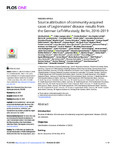Source attribution of community-acquired cases of Legionnaires’ disease–results from the German LeTriWa study
Buchholz, Udo
Jahn, Heiko Juergen
Brodhun, Bonita
Lehfeld, Ann-Sophie
Lewandowsky, Marina M.
Reber, Franziska
Adler, Kristin
Bochmann, Jacqueline
Förster, Christina
Koch, Madlen
Schreiner, Yvonne
Stemmler, Fabian
Gagell, Corinna
Harbich, Edith
Bärwolff, Sina
Beyer, Andreas
Geuß-Fosu, Ute
Hänel, Martina
Larscheid, Patrick
Murajda, Lukas
Morawski, Klaus
Peters, Uwe
Pitzing, Raimund
von Welczeck, Andreas
Widders, Gudrun
Wischnewski, Nicoletta
Abdelgawad, Inas
Hinzmann, Anke
Hedeler, Denis
Schilling, Birte
Schmidt, Silvia
Schumacher, Jakob
Zuschneid, Irina
Atmowihardjo, Iskandar
Arastéh, Keikawus
Behrens, Steffen
Creutz, Petra
Elias, Johannes
Gregor, Martina
Kahl, Stefan
Kahnert, Henning
Kimmel, Viktor
Lehmke, Josefa
Migaud, Pascal
Mikolajewska, Agata
Moos, Verena
Naumann, Maria-Barbara
Pankow, Wulf
Scherübl, Hans
Schmidt, Bernd
Schneider, Thomas
Stocker, Hartmut
Suttorp, Norbert
Thiemig, Dorina
Gollnisch, Carsten
Mannschatz, Uwe
Haas, Walter
Schaefer, Benedikt
Lück, Christian
Introduction
Sources of infection of most cases of community-acquired Legionnaires’ disease (CALD) are unknown.
Objective
Identification of sources of infection of CALD.
Setting
Berlin; December 2016–May 2019.
Participants
Adult cases of CALD reported to district health authorities and consenting to the study; age and hospital matched controls.
Main outcome measure
Percentage of cases of CALD with attributed source of infection.
Methods
Analysis of secondary patient samples for monoclonal antibody (MAb) type (and sequence type); questionnaire-based interviews, analysis of standard household water samples for Legionella concentration followed by MAb (and sequence) typing of Legionella pneumophila serogroup 1 (Lp1) isolates; among cases taking of additional water samples to identify the infectious source as appropriate; recruitment of control persons for comparison of exposure history and Legionella in standard household water samples. For each case an appraisal matrix was filled in to attribute any of three source types (external (non-residence) source, residential non-drinking water (RnDW) source (not directly from drinking water outlet), residential drinking water (RDW) as source) using three evidence types (microbiological results, cluster evidence, analytical-comparative evidence (using added information from controls)).
Results
Inclusion of 111 study cases and 202 controls. Median age of cases was 67 years (range 25–93 years), 74 (67%) were male. Among 65 patients with urine typable for MAb type we found a MAb 3/1-positive strain in all of them. Compared to controls being a case was not associated with a higher Legionella concentration in standard household water samples, however, the presence of a MAb 3/1-positive strain was significantly associated (odds ratio (OR) = 4.9, 95% confidence interval (CI) 1.7 to 11). Thus, a source was attributed by microbiological evidence if it contained a MAb 3/1-positive strain. A source was attributed by cluster evidence if at least two cases were exposed to the same source. Statistically significant general source types were attributed by calculating the population attributable risk (analytical-comparative evidence). We identified an external source in 16 (14%) cases, and RDW as source in 28 (25%). Wearing inadequately disinfected dentures was the only RnDW source significantly associated with cases (OR = 3.2, 95% CI 1.3 to 7.8) and led to an additional 8% of cases with source attribution, for a total of 48% of cases attributed.
Conclusion
Using the appraisal matrix we attributed almost half of all cases of CALD to an infectious source, predominantly RDW. Risk for LD seems to be conferred primarily by the type of Legionella rather than the amount. Dentures as a new infectious source needs further, in particular, integrated microbiological, molecular and epidemiological confirmation.
Dateien zu dieser Publikation

